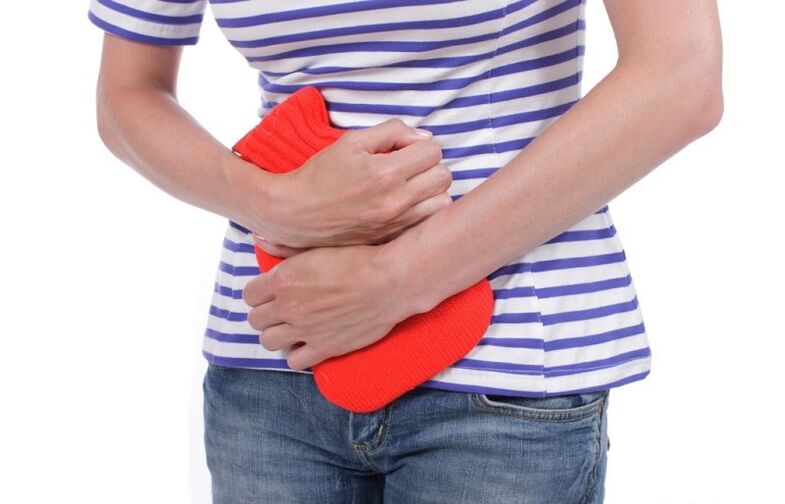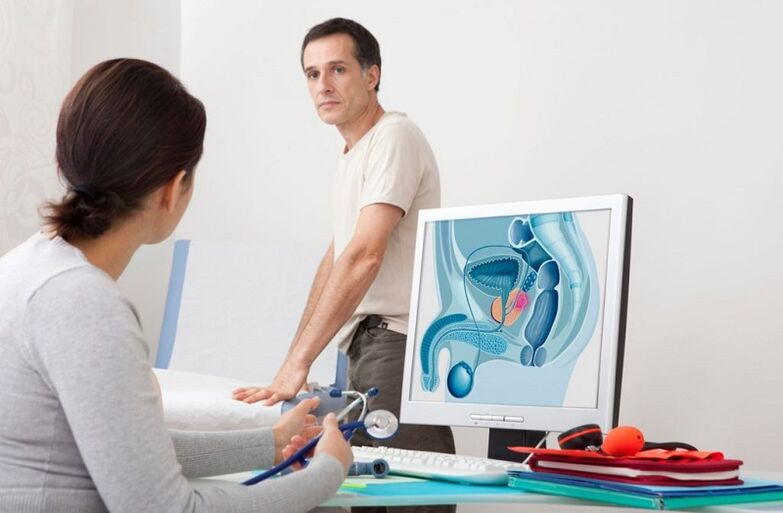Acute prostatitis is an infectious and inflammatory disease that covers the tissues of the prostate gland, causing extensive swelling and the appearance of purulent foci. The disease can manifest itself in different ways, depending on the stage of its development. Therefore, an integrated approach is needed for accurate diagnosis. Treatment of acute prostatitis is most often based on the use of drugs and physiotherapy techniques.
The reasons

Alcoholism can cause acute prostatitis.
The disease most commonly develops in men over 30 years of age. In most cases, the disease is caused by the negative effect of the pathogenic microflora on the male body. Thus, acute prostatitis in men is caused by the activity of the following microorganisms:
- Staphylococcus aureus;
- Pseudomonas aeruginosa and Escherichia coli;
- klebsiella;
- enterococcus;
- Proteus.
Most of the above microorganisms are continuously present in the human body while no inflammation is observed. When such bacteria enter the tissues of the prostate gland, the process of their active growth begins, resulting in severe inflammation in the prostate.
Bacteria can enter the urogenital system during unprotected sex. Therefore, it is very important that people who do not have a regular sexual partner use a condom.
Inflammation can be non-infectious, for the following reasons:
- obesity;
- sedentary lifestyle;
- rare sexual intercourse;
- significant hypothermia;
- interruption of intercourse;
- eating disorders;
- smoking and alcohol consumption.
The above factors create fertile ground to stagnate prostate secretions. However, stagnant blood processes are observed in vessels in the immediate vicinity of the organ.
Significant accumulation of prostate secretion creates a favorable environment for the growth of the pathogenic microflora. As a result, an inflammatory process develops. The latter can cause a number of complications, such as:
- BPH;
- abscesses;
- oncological process.
Important!Against the background of acute prostatitis, most men have problems with potency and are at risk of infertility.
Thus, there are individuals at risk for developing this disease who:
- no regular sex life;
- lack of physical activity;
- there are bad habits.
Shapes and sections

You should go to the hospital immediately if you have any symptoms of prostate discomfort.
In modern medicine, there are three main stages to this disease. Let's examine them in more detail:
- The first stage is called catarrh.It is characterized by the occurrence of the primary inflammatory process with the appearance of edema of the glandular tissue, the extent of the acini. In this case, the size of the prostate gland increases. If the disease is not treated, the inflammation gradually passes into the secretory ducts of the prostate glands that connect to the back of the urethra. Inflammation of the ducts of the prostate results in their gradual narrowing and occlusion, resulting in somewhat difficult secretion of prostate secretion. In the catarrhal stage of its development, the inflammatory process covers only the mucous membranes.
- This is followed by the follicular stage of the disease.It is characterized by a further progression of the inflammatory process in which the remaining tissues of the organ are gradually involved. As a result, an acute form of bacterial prostatitis develops. In the analysis of urine, pus is present at this stage of the disease. Although a significant number of tissues are damaged, the follicular form of prostatitis responds well to treatment.
- The last stage is called the parenchyma.It is characterized by a destructive change in the tissues of the prostate gland. However, the swelling gradually increases and the inflammatory process eventually covers the entire organ. If the development of the disease reaches this stage, the treatment process is very complicated, requiring radical measures. Without timely and appropriate treatment, chronic prostatitis can develop.
In the early stages of the disease, a subacute stage is usually distinguished. It is characterized by a weak severity of the signals, which is explained by the low activity of the pathogens. The disease can last for a long time at this stage if the patient’s body has good resistance. However, it is very difficult to diagnose the disease in the subacute stage, so most patients do not receive timely treatment.
Symptoms
Each form of this disease is characterized by its own symptoms. Therefore, consider them separately.
Hurut form

This form of the disease is characterized by frequent longing when there is little need for it.
Once the infection has reached the excretory channels, this stage of the disease develops. But even though the inflammatory process does not cross the mucous membrane, the prostate gland enlarges and swells. In this case, the urethra becomes constricted.
Symptoms of acute prostatitis are mild at this stage:
- due to compression of the canal, the patient may experience minor urination problems;
- at night, the urge to urinate becomes more frequent;
- possibly a 38 degree rise in body temperature;
- when the patient is in a sitting position, he may feel some difficulty in the perineum.
In some cases, the catarrhal form occurs without severe hyperthermia.
The symptoms of the disease alone may disappear a few weeks after development. And most patients in this case do not go to the doctor. However, this is fraught with the transition of the disease to a chronic state. Provided treatment for acute prostatitis is started in time, the disease will recur after 10 days.
Follicular form
If the catarrhal stage is not treated, the disease continues to develop, affecting some lobes of the organ. In this case, severe symptoms occur:
- sharp pains while urinating;
- the patient's body temperature is maintained around 38 degrees;
- dull pain appears in the perineum radiating to the penis;
- the process of urination is complicated;
- the patient has difficulty excreting due to the presence of severe pain.
Because this stage is characterized by a purulent lesion of the prostate, purulent fibers can be observed in the patient's urine. Provided the therapy is performed in a timely manner, complete recovery of the disease at this stage will occur in less than two weeks after the procedures begin.
Parenchymal form
It is also called diffusion. Because the inflammatory process covers the entire organ, the following symptoms occur:
- Perineal pain becomes almost unbearable. From time to time, they pass through the vaginal penis. Some pain relief is possible in a supine position when the patient presses both legs to his chest.
- Foreign body sensation in the rectum. There is significant pain in bowel movements. Constipation becomes more common, and when the inflammatory process turns into a reactive form, rectal mucus secretion begins.
- Severe urinary problems appear. In this case, both partial and complete urinary retention is possible.
- The body temperature can reach 40 degrees. The patient suffers from chills.
Diagnostics

A number of different tests will be needed to make a definitive diagnosis.
This disease is diagnosed by a urologist who performs a comprehensive examination using the following types of procedures:
- physical analysis;
- instrumental research;
- laboratory research.
During the initial examination of the patient, the specialist palpates the gland. This should be done very carefully, avoiding massaging movements and strong pressure. Otherwise, it can cause significant discomfort to the patient.
The main diagnostic method is to examine the prostate gland, which is done by inserting a probe into the rectum. This procedure allows professionals to obtain the following data:
- determines the pain response;
- identifies the main foci of destruction;
- confirms or rejects signs of purulent tissue fusion;
- evaluate the shape and symmetry, size, and consistency of the organ.
As a general rule, the secret of this organ is highlighted when the prostate is palpated. Its analysis makes it possible to accurately determine the presence of the inflammatory process. During the research, we check the number of leukocytes, amyloid bodies and other components.
- bacterial culture of urine and urethral emptying with antibiotics;
- PCR analysis of scraping;
- to draw blood to the blood culture.
The nature and severity of dysuric disorders during the acute course of the disease are assessed using uroflowmetry.
Ultrasound of the prostate gland with moderate pain syndrome is transrectal and, in the case of a severe pain reaction, transbdominal. They echoscopically assess the shape and size of the gland, the presence of focal or diffuse changes, and determine the stage of the acute inflammatory process.
Pelvic MRI should be performed during surgical planning of destructive forms of acute prostatitis.
Treatment of the disease
The main method of treating acute prostatitis is etiotropic therapy. This is based on the timely appointment of antimicrobial drugs to the patient, which prevents further development of the pathogenic microflora in the pelvic organs. In addition to medications, folk remedies and physiotherapy procedures are prescribed to the patient. A balanced diet plays a significant role in the treatment of acute prostatitis.
Medicines
Treatment of acute prostatitis should include elimination of the inflammatory infection. In addition, the task of therapy is to eliminate stagnation and normalize the circulatory process.
In most cases, outpatient treatment is used in patients with acute prostatitis. If the patient is in parenchymal form, they are hospitalized.
Therapy for acute infectious prostatitis involves the mandatory intake of antibiotics. In this case, the duration of treatment is determined by a specialist, as well as the drugs used.
Antibiotics of different groups are active against different microorganisms. Therefore, professional treatment is performed only on the basis of a thorough diagnosis. This allows the doctor to choose exactly the treatment that will be effective against a particular pathogen. Treatment is usually done with medicines from these groups:
- fluoroquinolones;
- penicillins;
- macrolides.
The former are considered to be the most effective. For this reason, they are most commonly used in the treatment of acute prostatitis.
Although antibiotics are the mainstays of treatment, they are not the only drugs used to treat acute prostatitis. In particular, antihistamines and intestinal-friendly bacteria are prescribed to patients.
Stimulation of the immune system is very important at all stages of the treatment of acute prostatitis. For this reason, immunostimulatory drugs are prescribed to patients.
In addition to the above agents, interferons are used to treat acute prostatitis. It is possible to take such drugs in the form of tablets and intramuscular injections. The latter option is preferred.
Physiotherapy
With the right choice of medication for acute prostatitis, the severity of the symptoms of the disease is significantly reduced. The following physiotherapy techniques are used to consolidate the results obtained:
- Microwave and UHF therapy;
- rectal electrophoresis;
- prostate massage.
Folk remedies

Many experts argue that curing acute prostatitis alone is impossible using traditional medicine. In addition, such self-medication can greatly aggravate the disease and lead to a number of complications. In this case, folk recipes can only be used as a supplement to official medicines. In addition, many pharmaceutical preparations are made from various plants.
As a general rule, in the acute form of prostatitis, patients are prescribed various infusions and decoctions. They should be taken orally while bathing or used to make a healing solution. The most effective in this case are the following plants:
- chestnut;
- mother and stepmother;
- horsetail;
- Oak bark;
- chamomile.
Dietary food
The key to a cure for acute prostatitis is a balanced diet. The inclusion of certain products in a patient’s weekly menu is based on the severity of the disease. However, regardless of the stage of the disease, the following foods should be excluded from the diet for some time:
- smoked meats;
- fried foods;
- Preservation;
- strong tea and coffee;
- alcoholic drinks;
- spicy and savory foods;
- fatty fish and meat.
Prophylaxis

Sports activities are very useful in preventing prostate disease.
Prevention of acute prostatitis involves the timely cessation of the inflammatory process. This requires timely treatment of bacterial, fungal and viral diseases. However, any medical manipulations associated with endourethral or endovesical examinations should be performed following appropriate aseptic rules.
Effective prevention of acute prostatitis is based on the following principles:
- Strengthening the immune system.
- Sexual hygiene.
- She has a regular sex life.
- Systematic physical activity and walking in the fresh air.
- Rejection of bad habits.
- Normalization of diet.
Periodic prostate massage can be an excellent prevention of many urological diseases.
If you notice the first signs of prostatitis, don’t hesitate - you should see a specialist as soon as possible. This helps the disease to heal faster and prevent many negative consequences.




































